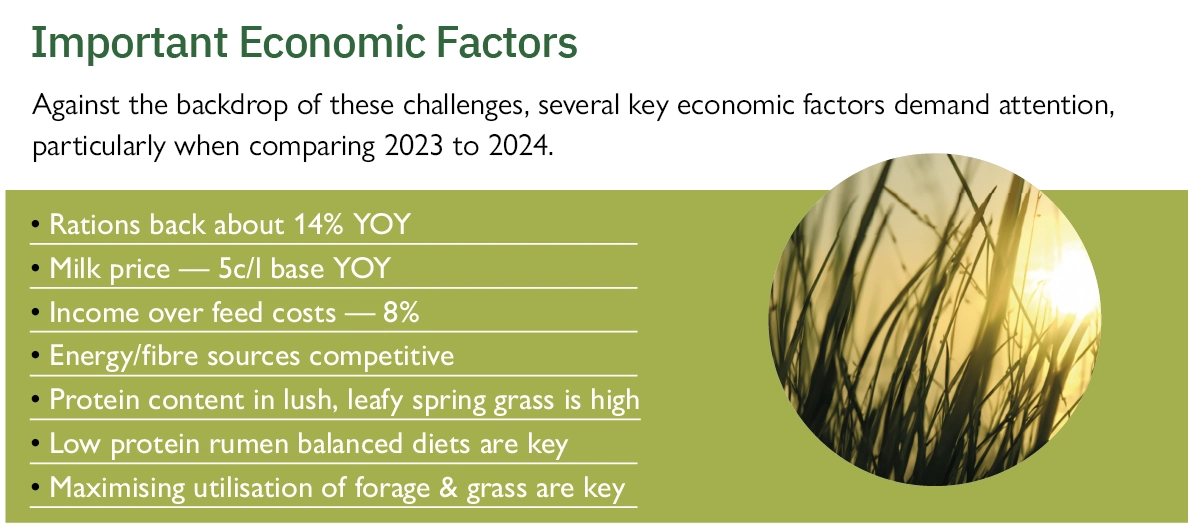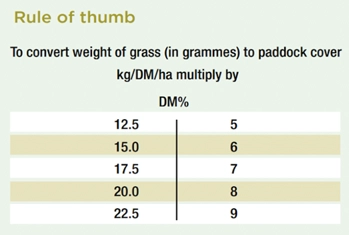Specialist Nutrition US
Suite 101, 5010 Campuswood Drive, East Syracuse, NY 13057
Specialist Nutrition US
Suite 101, 5010 Campuswood Drive, East Syracuse, NY 13057
Specialist Nutrition US
Suite 101, 5010 Campuswood Drive, East Syracuse, NY 13057

As the seasonal spring weather approaches (hopefully), dairy farmers across Ireland eagerly anticipate the transition from winter rations to lush green pastures. However, the shift from stored feed to fresh grazing can present challenges, particularly concerning dry matter intake (DMI) management. In this comprehensive guide, we will explore the importance of assessing dry matter content in spring grass and its impact on cow health and performance during turnout. We’ll also delve deep into the complexity of spring-summer grazing, exploring the key economic parameters, challenges, and strategies for maximising efficiency and profitability during this critical period.
The transition to spring-summer grazing brings forth a host of challenges that demand careful consideration and strategic planning.

Against the backdrop of these challenges, several key economic factors demand attention, particularly when comparing 2023 to 2024.
Rations have seen a notable decrease year over year, reflecting cost-saving measures implemented by dairy farmers in response to economic pressures. Similarly, milk prices have experienced a decline, placing additional strain on farm profitability. Income over feed costs has also witnessed a reduction, highlighting the need for strategic interventions to optimise resource utilisation and maximise efficiency.
Energy and fibre sources emerge as competitive elements in the feed market, with dairy farmers seeking cost-effective alternatives to meet the nutritional needs of their herds. Balancing the nutritional composition of feed rations while controlling costs remains a critical priority for farm sustainability and profitability.
To address the challenges and optimise economic factors during spring-summer grazing, dairy farmers can implement a range of strategic measures:
Grass dry matter serves as a critical determinant of feed quality and intake. Regular assessment of grass dry matter content enables farmers to make informed decisions regarding feed allocation, grazing management, and supplementation strategies. By accurately measuring grass dry matter, farmers can optimise dry matter intake (DMI) and ensure herd nutrition and productivity.
Dry matter content is a critical factor in evaluating the nutritional value of spring grass. Unlike stored forages like grass silage, where dry matter content remains relatively consistent, the moisture content of spring grass can vary significantly depending on environmental conditions. Variations in dry matter content directly influence DMI, making accurate assessment essential for proper grazing management.
Grass with a higher DM percentage tends to contain more dead material at the sward base, indicating lower nutritional value. Conversely, grass with a lower DM percentage is typically greener and leafier, signalling higher nutritional quality. It's crucial to note that afternoon DM readings often register 2-3 units higher than morning measurements, highlighting the importance of consistency in monitoring grass DM content throughout the day for precise grazing decisions.
Several methods can be employed to assess the dry matter content of spring grass effectively. Utilising a quadrant and shears, farmers can sample grass from representative areas of the pasture, removing water content to determine dry matter yield per hectare. Alternatively, plate metres or advanced devices like the Grasshopper offer precise measurements of compressed grass height, allowing for accurate estimation of dry matter content.
 |
 |
The variability in dry matter content directly impacts cow DMI and, consequently, overall herd health and productivity. High moisture content in spring grass reduces the amount of dry matter consumed per kilogram of fresh grass, potentially leading to underestimation of DMI and compromising cow performance. Conversely, low moisture content can result in increased dry matter intake, but excessive levels may lead to reduced palatability and rumen function.
Effective management of dry matter intake during spring turnout is crucial for optimising cow health and productivity. Gradual transition to grazing allows rumen microbes time to adapt to changes in diet, mitigating the risk of digestive upsets. Monitoring dry matter content regularly enables farmers to adjust grazing strategies and supplement with buffer feeds strategically to maintain optimal DMI levels.
Dry matter recommendations:
Buffer feeding plays an important role in maintaining consistent production levels, particularly during periods of bad weather or fluctuating pasture conditions.
Buffer Feeding Importance:
By supplementing grazing with high-energy forages or concentrates, farmers can mitigate the impact of variable grass quality and availability on herd performance. Strategic buffer feeding not only supports optimal DMI but also enhances rumen health and nutrient utilisation, contributing to overall herd productivity.
When it comes to cow turnout and supplementary buffer feeding, several key considerations are vital for ensuring optimal herd health and productivity:

Spring-summer grazing often happens at the same time as fluctuations in milk butterfat levels. In fact, we can see up to 0.5% drop in butterfat among grazing cows. To address this issue, farmers can adopt a holistic approach encompassing grazing management, buffer feeding, and rumen health strategies. By optimising pre-grazing covers, promoting high dry matter intake, and maintaining appropriate pasture covers, farmers can mitigate the risk of milk fat depression and ensure consistent milk quality and composition.
Avoiding Over Fertilisation: Over-fertilisation on young, high-sugar grass increases the risk of milk fat depression. Excessive nitrogen application can lead to rapid grass growth, resulting in high-sugar, low-fibre grass that predisposes cows to metabolic disorders and milk fat depression. To mitigate this risk, farmers should carefully monitor and adjust fertiliser application rates based on grass growth rates, weather conditions, and nutritional requirements.
Maintaining Cow Body Condition: Consistent body condition monitoring and management are essential for optimising herd health, fertility, and productivity. During the spring-summer grazing season, cows may experience fluctuations in body condition due to changes in diet, pasture conditions, and metabolic demands.
Generally, cows will be in a negative energy balance (NEB) for around 50 days post-calving, and it's crucial to keep this loss to less than 0.5 body condition score (BCS) over this period (< 0.5kg/cow/day). Ideally, cows should maintain a BCS of 3.0 at first service.
To minimise excessive body condition loss post-calving and ensure optimal fertility, farmers should prioritise balanced nutrition, adequate pasture management, and regular monitoring of cow health and performance.
Spring-summer grazing brings both challenges and opportunities for dairy farmers looking to improve herd productivity and profitability. By taking a proactive and strategic approach to grazing management, farmers can overcome obstacles like unpredictable weather, cost pressures, and nutrient variations, while maximising efficiency and optimising economic factors.
Through practices such as regular assessment of grass dry matter, strategic buffer feeding, proactive milk fat management, and careful pasture management, farmers can ensure the best possible herd health, productivity, and profitability during this critical grazing season.
For expert advice and assistance in implementing these strategies, don't hesitate to contact Specialist Nutrition and consult with our experienced team. As experts in the health and nutrition of dairy cattle, our technical consultants offer high-quality feed and nutritional solutions to guarantee successful spring-summer grazing. Contact us today to get expert advice and take your dairy operation to the next level.
